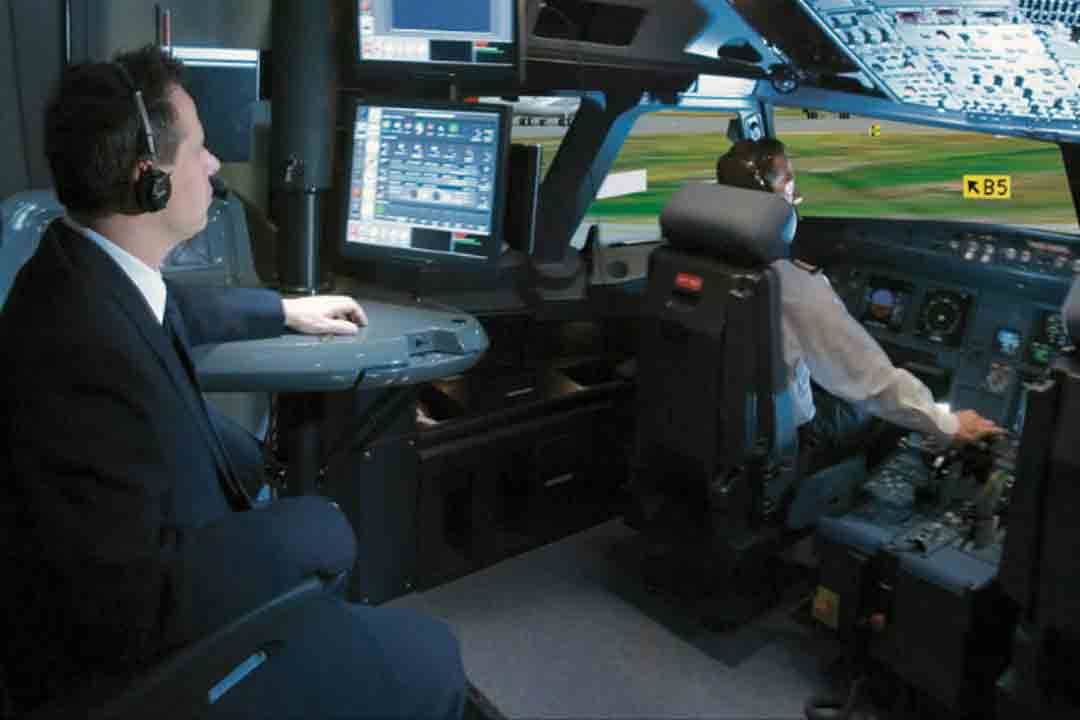In this part, you will tell me what you can see in this picture and what you think is happening in it. After that, I will ask you some questions. Look at the picture carefully. You may take a few moments to think before you start talking.
Are the instructions clear?
SUGGESTED INTERACTION:
ICAO 5:
This picture shows me a pilot in a flight simulator session during the flight.
The pilot is flying a twin engined-jet aircraft, I say that because I can see clearly the double thrust levers on the pedestal of the simulated aircraft.
There are also screens and digital gauges showing all information about the flight, navigation, system and engines of the simulated aircraft and just above it is possible to see the overhead with its various knobs.
The pilot in training seems to be very comfortable since the simulated aircraft is on the ground.
Behind of this pilot we can see a man who could perhaps be an instructor or even an examiner, keeping track of this session or assessing this possible check.
I would say that is a typical routine Flight simulator training, check ride or maybe a recheck.
Flight simulators are totally needful, handy and indispensable, for pilots training.
They are safe, economics and provide an efficient way of training pilots for various situations since normal to abnormal procedures without putting passengers, crew and the integrity of the aircraft at risk.
ICAO 4:
First of all, in this photo I can see two people in the flight simulator, one is the student and the other is the instructor.
The instructor is sitting at the simulator control station.
Well … I don’t know exactly what kind of simulated aircraft is, but it looks like a big aircraft.
This type of training is very important, as the pilot can train in different situations such as: Engine failure, bird strike and also bad weather conditions, like: windshear and poor visibility.
When pilots face all situations like these, they will be prepared to deal with them.
Examiner: What do you think happened before this picture was taken?
SUGGESTED INTERACTION:
ICAO 5: Before this picture has been taken, I guess the pilot must have gotten the briefing from the examiner with all essential and important instructions for a better Pilot’s performance during the session.
ICAO 4: Before this photo was taken, the pilot received a briefing with all information about: Procedures, maneuvers and failures.
Examiner: Imagine that this picture has just been taken. what do you think will happen next?
SUGGESTED INTERACTION:
ICAO 5: Next, I believe the instructor will wind up the flight simulation session and then will perform the debriefing by giving some information, pointing out all the mistakes and successes and finally, saying if the pilot has been approved or disapproved, in case it has been an exam.
ICAO 4: Next, I think the pilot will receive a debriefing from instructor. Probably the instructor will point out all the mistakes and successes and he will say if the student will be approved or disapproved.
Examiner: Has safety increased due to the use of simulators?
SUGGESTED INTERACTION:
ICAO 5: Yes, safety has been greatly increased with the use of flight simulators. With this training, pilots can practice routine, non-routine and emergency situations and further improve their flying skills.
ICAO 4: Yes, safety has increased a lot due to the use of flight simulators. With this training, pilots can practice the routine, non-routine and emergency situations and improve more and more their flight skills.
Examiner: What is the most challenging emergency situation a pilot may deal with? Why?
SUGGESTED INTERACTION:
ICAO 5: I believe those situations involving fire on board are the most challenging events that pilots can face on a flight.
If there is fire on board, especially in some specific areas of the aircraft where the crew cannot reach it to put out the fire, for example in the cargo hold, immediate descent and an emergency landing at the nearest suitable airport for assistance will be extremely required.
Fire can spread out quickly and can consume parts, components and systems which are very important for a safe flight.
.
ICAO 4: In my opinion, the most challenging emergency situation the pilot can deal with is: Engine failure after takeoff because the pilot cannot have enough altitude and time to return and land safely.
Now, I am going to read a statement to you and then you will have to tell me to what extent you agree or disagree with it.
“Dealing with emergency situations in simulators is easier than in a real flight.“
SUGGESTED INTERACTION:
ICAO 5:
I agree with the statement because in a flight simulator session, pilots are safe on the ground and can make mistakes without putting passengers and their own lives at risk.
The same is not possible on a real flight, as they are under high pressure and cannot make mistakes, once the safety of everyone on board is at stake.
ICAO 4: I totally agree with this statement, because during the flight simulation session, pilots can train in different situations, for example: engine failure, depressurization, bird strike, tail strike and so on.
It is very safe to train these situations on the ground without putting people and aircraft at risk, not mention It has a lower cost than the real aircraft.
